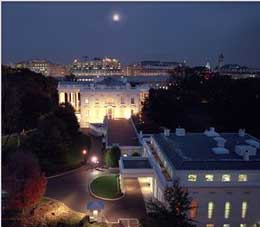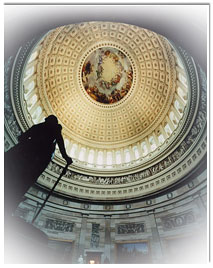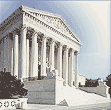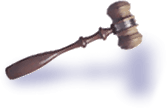| |
Introduction
The United States of America is a democracy, which means it is governed
by the will of its people. Its government provides a system of management
for American citizens. Established in 1789, the United States is a federal
republic, with a strong democratic tradition. Its legal system is based
on English common law. The government is divided into separate governing
units. At the top level is the Federal Government, which provides functions
that are best managed by a centralized government, such as defense, currency
regulation, and foreign relations. Its capital city is Washington, D.C.
Federal Government
At the Federal level, there are three branches of government: executive,
legislative, and judicial. These branches work in concert under a set
of checks and balances that ensure a relatively even distribution of authority
and power.
The executive branch is in charge of executing Federal  laws and is led by the head of state, President George W. Bush (since
January 20, 2001). The president is both the head of state and the head
of government. The President appoints a Cabinet whose members are approved
by the Senate in the legislative branch. The President is elected, along
with a Vice President, to a 4-year term by the electoral college whose
members are elected directly from each State. The State popular votes
determine how the electoral college members vote. The next presidential
election will be held in November 2004.
laws and is led by the head of state, President George W. Bush (since
January 20, 2001). The president is both the head of state and the head
of government. The President appoints a Cabinet whose members are approved
by the Senate in the legislative branch. The President is elected, along
with a Vice President, to a 4-year term by the electoral college whose
members are elected directly from each State. The State popular votes
determine how the electoral college members vote. The next presidential
election will be held in November 2004.

The legislative branch is responsible for the creation of Federal laws.
Its members of Congress are directly elected representatives of
the people. The Congress consists of the Senate and the House of Representatives.
The Senate has 100 seats, and one-third of these are contested in elections
every 2 years. There are 435 seats in the House of Representatives, and
each Representative is elected to a 2-year term.

The judicial branch interprets Federal laws. The highest court in the
United States, the Supreme Court, is part of this branch. The President
appoints its nine justices for life, with confirmation by the Senate.
The Supreme Court's judicial power extends to all cases related to the
American Constitution, the laws of the United States, disputes between
States, and treaties. It is also the final appellate court. The judicial
branch also includes the U.S. courts of appeal, U.S. district courts,
and State and county courts.
State and Local Governments
The next level of government in the United States includes each of the
50 States plus the government of the District of Columbia. The States
have a good deal of autonomy and authority over issues that are within
State borders, including internal communications; regulations relating
to property, industry, business, and public utilities; the State criminal
code; and working conditions. In alphabetical order, the States are:
Alabama |
Alaska |
Arizona |
Arkansas |
California |
Colorado |
Connecticut |
Delaware |
Florida |
Georgia |
Hawaii |
Idaho |
Illinois |
Indiana |
Iowa |
Kansas |
Kentucky |
Louisiana |
Maine |
Maryland |
Massachusetts |
Michigan |
Minnesota |
Mississippi |
Missouri |
Montana |
Nebraska |
Nevada |
New Hampshire |
New Jersey |
New Mexico |
New York |
North Carolina |
North Dakota |
Ohio |
Oklahoma |
Oregon |
Pennsylvania |
Rhode Island |
South Carolina |
South Dakota |
Tennessee |
Texas |
Utah |
Vermont |
Virginia |
Washington |
West Virginia |
Wisconsin |
Wyoming |
|
|
Within the States, smaller local units govern counties, cities,
towns, and villages. These local governments directly serve the needs
of residents by providing everything from police and fire protection to
sanitary codes, health regulations, education, public transportation,
and housing.
Dependent Areas
Finally, the United States includes a number of dependent areas. Baker
Island, Howland Island, Jarvis Island, Johnston Atoll, Kingman Reef, Midway
Islands, Navassa Island, Palmyra Atoll, and Wake Island are unincorporated
territories, administered by the Federal Government. Three unincorporated
territories, American Samoa, Guam, and the U.S. Virgin Islands, are governed
locally on the basis of U.S. laws. Puerto
Rico is a Commonwealth that has authority over its internal affairs
but relies on the Federal Government for issues that cross its borders.
From 1947 until 1994, the United States administered the Trust Territory
of the Pacific Islands, but it recently entered into a new political relationship
with all four political units. The Northern Mariana Islands is a Commonwealth
in political union with the United States. Palau, the Federated States
of Micronesia, and the Republic of the Marshall Islands signed Compacts
of Free Association with the United States. For more information about
U.S. dependent areas please go to the CIA
World Factbook.
Federal Government and the National Atlas
More than 20 agencies of the Federal Government bring the National Atlas
of the United States® to you. We use this forum not only
to deliver maps and services, but also to acquaint you with the work of
these agencies. The Atlas typically includes data for all 50 States, Puerto
Rico, and the U.S. Virgin Islands. It does not include data for the dependent
areas at this time. There are also some maps and datasets in nationalatlas.gov™
that only include the conterminous States. |
|
|
|




